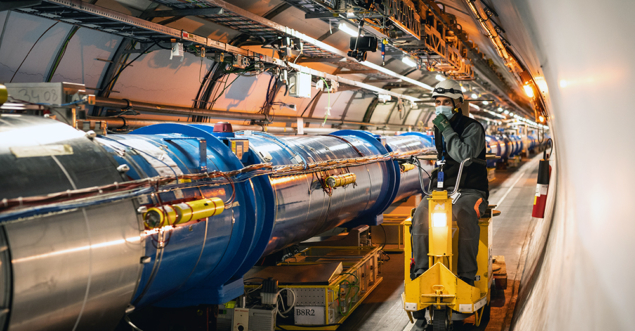
The second long shutdown of the LHC and its injector complex began two years ago, at the start of 2019. Since then, sweeping upgrades in the accelerator complex and key maintenance work have resulted in a rejuvenated accelerator complex with injectors fit for a decade or more of high-brightness beam production. With major detector upgrades proceeding in parallel, physicists are eyeing the final stretch of the road to Run 3 – which promises to deliver to the experiments an integrated luminosity twice that of Run 1 and Run 2 combined in less than three years of operations.
A large number of physicists, engineers and technicians have strived day-in day-out
Rende Steerenberg
The ceremonial key to the Super Proton Synchrotron (SPS) was handed over to SPS operations on 4 December, signalling the successful completion of the LHC Injectors Upgrade (LIU) programme. “The amazing accomplishment of delivering the machine keys with only a small delay is thanks to the hard work, dedication and flexibility of many,” says head of the operations group Rende Steerenberg, who emphasised the thoroughness with which special measures to ensure the safety of personnel during the COVID-19 pandemic were observed. “A large number of physicists, engineers and technicians strived day-in day-out to complete the upgrade and consolidation of the accelerator complex safely and efficiently following the spring lockdown.”
Super synchrotrons
Major changes to the SPS include the dismantling and remounting of its radio-frequency cavities, the installation of new power amplifiers, and the installation of state-of-the-art beam-control and beam-dump systems. First beam from the new Linac 4 was injected into the upgraded Proton Synchrotron Booster (PSB) on 7 December. The PSB will undergo a commissioning period before injecting beam into the Proton Synchrotron (PS) on 1 March. It will then be the turn of the PS to be commissioned, before sending beam to the SPS on 12 April.
Among many changes to the LHC, all 1232 dipole-magnet interconnections were opened and their electrical insulation consolidated, removing the limitation that prevented the LHC from reaching 7 TeV per beam during Run 2. The cryogenics team cooled the first of the LHC’s eight sectors to its 1.9 K operational temperature on 15 November, with five other sectors being cooled in parallel and the full machine set to be cold by spring. After handing over to the electrical quality-assurance team for the final electrical tests, powering tests and a long campaign of quench training will take place to enable the LHC magnets to support fields in excess of those required during Run 2, when the beam energy was 6.5 TeV. Test beams are due to circulate at the end of September 2021, just four months later than planned before the COVID-19 pandemic.
All 1232 dipole-magnet interconnections were opened
Detector work
In parallel to work on CERN’s accelerator infrastructure, experimental physicists are working hard to complete major upgrades to the detectors which anticipate the stringent requirements of triggering and reconstructing events at the upgraded LHC. The refurbishment of trigger electronics for the ATLAS detector’s liquid-argon calorimeter is progressing quickly and the construction of the muon detector’s two new “small wheels” is set to be completed by October 2021. With a complex upgrade of the CMS detector’s muon system now complete, a newly built beam pipe will soon be fitted in the cavern, followed by the refurbished pixel detector with a new inner layer; magnet upgrades and shielding consolidation will then follow. With ALICE’s time-projection chamber now reinstalled, work is underway to install the detector’s new muon forward tracker, and a new 10 GPixel inner-tracking system will be installed in the first quarter of 2021. Meanwhile, the next steps for a significant revamp to the LHCb detector are the mounting of new vertex-locator modules and the first sensitive detector parts of the new ring-imaging Cherenkov detector during the first months of 2021. Following the completion of the upgrade programmes, Run 3 of the LHC will begin in March 2022.
Accelerator infrastructure relating to earlier stages in the lives of LHC protons is already beginning to be recommissioned. Hydrogen ions from a local source have been transferred to the ELENA ring to commission the newly installed transfer lines to CERN’s antimatter experiments. A newly developed source has fed lead ions into Linac 3, which provides ions to the LHC’s physics experiments, while pre-irradiated targets have provided stable isotopes to the ISOLDE nuclear-physics facility. Many experiments at ISOLDE and the PS-SPS complex will be able to start taking data in summer 2021.
No changes have been made to the LHC schedule beyond 2022. Following the completion of Run 3, the third long shutdown will begin at the start of 2025 for the LHC, and in early 2026 for the injector chain, and will end in mid-2027. During this time the installation of the High-Luminosity LHC (HL-LHC) will be completed, adding major high-technology upgrades to CERN’s flagship machine. In concert with the programme of injector upgrades completed in LS2, these will allow the HL-LHC to deliver an order-of-magnitude greater integrated luminosity to the experiments than its predecessor.





